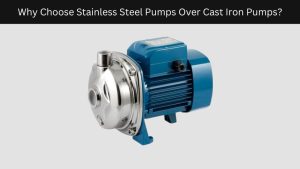In industries where reliable fluid transfer is essential, pump performance directly impacts productivity, operational costs, and equipment lifespan. Among the various pump technologies available, Self Priming Regenerative Pumps stand out for their ability to combine compact design with dependable efficiency. Their operational advantages make them an ideal choice for a wide range of industrial processes, from water circulation to chemical handling.
In this blog, Inox Pump takes a closer look at how these pumps achieve efficiency, the factors influencing their performance, and why they are a preferred solution in many industrial settings.
1. How Self Priming Regenerative Pumps Work
A self priming regenerative pump uses a specialized impeller design to impart energy to the fluid multiple times during one revolution. The “regenerative” action creates a continuous transfer of fluid, which increases pressure without needing large pump sizes.
The self-priming capability means the pump can evacuate air from the suction line and start pumping liquids without manual priming, reducing downtime and simplifying operations.
2. Key Factors Contributing to Their Efficiency
a. Self-Priming Capability
In many industrial systems, pumps must handle conditions where air enters the suction line, such as during intermittent operation or after maintenance. Traditional pumps require manual priming in such cases, leading to delays. Self-priming regenerative pumps eliminate this step, ensuring quick start-up and consistent flow.
b. Energy Utilisation
The regenerative impeller design efficiently transfers energy to the liquid multiple times per revolution. This design enables higher pressure generation compared to similarly sized centrifugal pumps, making them suitable for applications requiring compact equipment without sacrificing performance.
c. Reduced Footprint
Space is a premium in industrial environments. These pumps offer high head per stage with smaller overall dimensions, which means more efficient use of floor space and easier integration into existing systems.
3. Industrial Applications That Benefit from High Efficiency
The versatility of self priming regenerative pumps means they are used in diverse sectors. Some notable examples include:
- Chemical Processing: Handling low-viscosity chemicals with precision while maintaining consistent flow rates.
- Boiler Feed Systems: Delivering water to boilers with the necessary pressure and reliability.
- Water Treatment Plants: Circulating and transferring water through filtration and treatment processes.
- Cooling Towers & HVAC Systems: Providing steady water flow for heat exchange efficiency.
- Textile Industry: Supplying process water with consistent pressure for dyeing and finishing operations.
In all these cases, the pump’s efficiency translates to reduced energy consumption and lower operational costs.
4. Maintenance and Efficiency Retention
To maintain efficiency over time, certain operational and maintenance practices should be followed:
- Regular Inspection: Check seals, bearings, and impellers for wear.
- Proper Lubrication: Keep bearings lubricated according to the manufacturer’s recommendations.
- System Monitoring: Monitor flow rate, pressure, and vibration levels to detect early signs of inefficiency.
- Clean Suction Lines: Prevent blockages that could impact priming ability and flow performance.
Routine maintenance ensures that the pump continues operating close to its original performance specifications, extending its lifespan and reducing energy waste.
5. Advantages Over Alternative Pump Types
a. Versus Centrifugal Pumps
While centrifugal pumps are widely used, they often require larger impellers or multiple stages to achieve similar pressure. Self-priming regenerative pumps achieve this with a more compact footprint and lower initial investment in certain applications.
b. Versus Positive Displacement Pumps
Positive displacement pumps can handle high pressures, but they may be more complex to maintain. Regenerative pumps strike a balance between pressure capability and ease of maintenance, making them cost-effective for specific industrial uses.
6. Operational Cost Savings
Efficiency isn’t just about performance—it’s about the total cost of ownership. Self priming regenerative pumps help industries save costs by:
- Reducing Energy Use: Optimised hydraulic design means less power consumption for the same output.
- Lowering Downtime: Quick self-priming reduces interruptions in operations.
- Minimising Maintenance Costs: Simpler designs require fewer complex repairs.
When calculated over the pump’s service life, these savings can be significant.
7. Best Practices for Maximizing Efficiency
To fully leverage the benefits of these pumps in industrial applications, consider the following:
- Select the Right Model: Match pump specifications to system requirements, including head, flow rate, and fluid properties.
- Install Properly: Ensure correct alignment, secure mounting, and adequate suction conditions.
- Avoid Overloading: Operating within the recommended performance range prevents unnecessary wear.
- Train Operators: Skilled handling reduces misuse and enhances longevity.
8. Why Inox Pump Company Recommends Them
At Inox Pumps, we have seen firsthand how self priming regenerative pumps improve industrial processes. Their combination of compact size, self-priming capability, and reliable performance makes them a strong choice for sectors where operational efficiency is a top priority. By helping clients select the right model and providing expert installation support, we ensure that every pump delivers maximum value over its service life.
Conclusion
Efficiency in industrial pumping systems is about more than just flow rates—it’s about operational reliability, energy savings, and long-term cost reduction. Self Priming Regenerative Pumps excel in these areas, making them an excellent choice for a variety of industrial applications. With proper selection, installation, and maintenance, these pumps can provide years of dependable, efficient service. Partnering with an experienced supplier like Inox Pumps ensures you get the right solution tailored to your operational needs.






